


![]() FORCES ON MOVING CHARGES - cont'd
FORCES ON MOVING CHARGES - cont'd
![]()
What is the motion of a charged particle in a dipole magnetic field such as that of the Earth's?
If we look at the Earth's dipole field it is almost as if we had taken a number of magnetic bottles that we talked about earlier, bent them round and attached the ends to the north and south poles of the Earth. Clearly such a field will have field gradient along the lines of force. But we also know that as we go vertically from the Earth's surface the magnetic filed strength decreases so there is also a field gradient perpendicular to the lines of force.
Thus we can expect both the effects discussed above to be manifest for the charged particles in the Earth's magnetic field.
This is indeed what happens and is the reason for the so called Van Allen Radiation Belts where charged particles, which originate from the Sun and travel across as part of the solar wind, are trapped in the Earth's magnetic field. Both electrons and protons are stored in the belts.
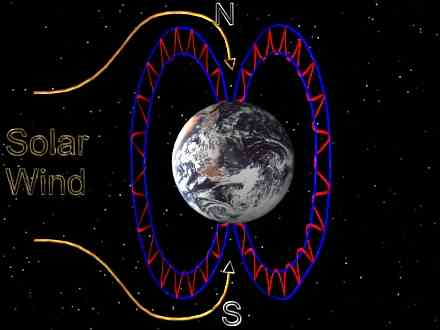
IMAGE - The Van Allen Belts.
The solar wind interacts with the Earth's magnetic field resulting in a magnificent display called the Auroras Borealis.
There are two kinds of motion that result.
Both the electrons and the protons spiral along the field lines going out to several Earth radii before coming back where they are then reflected in the polar regions where the field is greatest. These regions are also closest to the Earth and collisions between the charged particles and the atoms in the upper atmosphere cause their energies to be dissipated and for some of the particles to leak out of their magnetic storage bottles. These give rise to the spectacular auroral displays that are seen at high latitudes.
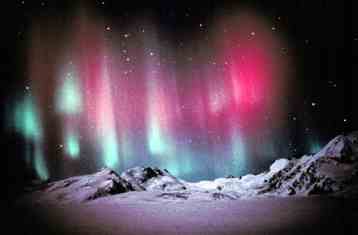
IMAGE - The Auroras Borealis.
Please move mouse over image.
Here are some interesting (approximate) figures that quantify these motions
The other motion results from the variations in field strength perpendicular to the field lines. These cause the charged particles to drift round the Earth in an equatorial direction; the electrons drift from west to east whilst the protons drift from east to west. These drifts represent independent circulating, ring currents (flow of charged particles) each with their associated dipole magnetic fields.
As we have said before, the Sun ejects energetic particles as well as photons of light. The particle component is what is known as the solar wind. Since this contains moving charged particles (electrons and protons) it carries with it a magnetic field and this magnetic field then interacts with the Earth's magnetic field (indeed, it is the Earth's magnetic field which shields us from the harmful particle fluxes, in an analogous way to that by which the Earth's atmosphere protects us from the harmful UV and X-ray solar emissions).
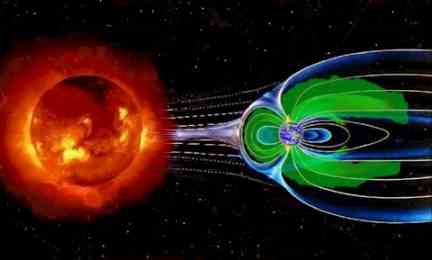
IMAGE - A computer model of the Sun's solar wind interacting with the Earth's magnetic field - courtesy of NASA.
When the surface of the Sun becomes more active, as it does from time to time, enhancements of the solar wind and the magnetic field it carries, occur. When this enhanced field interacts with the Earth's field, the latter is compressed, the field lines are forced closer together with the result that the Earth's magnetic field strength in increased on the Earth side of this interacting boundary (called the magnetosphere). Some of these particles leak into the van Allen belts and cause an increase in the equatorial circulating currents. This increases the dipole field associated with these currents which is in fact opposite to the Earth's permanent magnetic dipole field. Hence there is then a reduction in the total field which itself then diminishes over a period of days as the particles leak from the belts into the Earth's upper atmosphere.
This whole process is known as a magnetic storm.
![]()
Are the charged particles in the van Allen Belts and in the solar wind harmful to satellites?
When an energetic particle interacts with matter, it is a bit like a bullet going through the human body; it leaves a trail of devastation because many of the chemical bonds which hold the fabric of the material together are broken along the path. The degree of damage depends on the nature of the charged particle and on its energy.
In its mildest form the interactions produce noisy signals, that is they have the same kind of effect as that produced by the photons which the instruments are trying to detect, except they are unwanted and are hence classified as noise.
In its strongest form it damages components to the point where they become inoperative. Such occurrence are termed Single Event Upsets (SEUs) and are most damaging to on board computer components. In order to counteract these SEUs the components are radiation hardened (ie fabricated using different technology) to make them less susceptible. In addition sensitive electronics are screened with in metal boxes which act as proton shield and absorb most of the energy of the damaging particles.
ANIMATION - A solar eruption hundreds times larger than the diameter of the Earth!
This image was taken by the LASCO imager on board a satellite called SOHO. Birmingham University played a major role in the construction of the instrument which has been successfully taking images of the sun over the past four years
XMM makes use of both techniques.
![]()
What is the Pinch Effect?
The overall motion of the charged particles in the Earth's magnetic field as described above is quite complicated; this mirroring between the poles whilst at the same time circulating the Earth.
If we were to eliminate the first effect, what we are essentially left with are two ring currents flowing round the same ring (rather like the inner tube of a bicycle wheel) but in opposite directions; one ring current due to the electrons and the other to the protons.
An imposed magnetic field is required to set up the motion in this tube in the first place, but when that motion is established what we have is electrons moving in this field together with the magnetic field associated with the motion of the protons. Similarly the protons move in the established field together with the field of the moving electrons. The overall effect is to have a magnetic field which is increasing (with time) and, since the particles can move in response to the field via the Lorentz force, the ring currents are forced into a tube of smaller cross-sectional area. That is to say the currents are "pinched" and become more concentrated within the tubes. We should not be too surprised by this overall effect; after all, protons and electrons do attract each other.
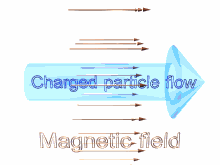
ANIMATION - The pinch effect
Scientists use this effect to narrow a particle beam. By colliding to particle beams head on, massive energies can be obtained which are used to probe the atom and its constituent parts
If this process is continued then a situation arises where there is a high possibility that the protons moving around the ring in one direction can collide with the electrons moving round the ring in the opposite direction. If the fields can be made large enough then the particles can become very energetic. This is the basis of a rather special particle accelerator which is used to investigate the fundamental interactions of energetic particles.
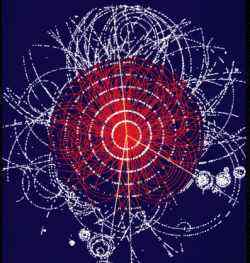
IMAGE - A collision simulation - courtesy of CERN.
This image shows the tracks made by elementary particles after a high energy collision. During the collision so much energy is created that new particles are formed.


